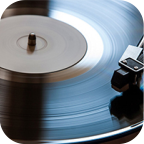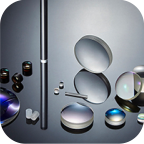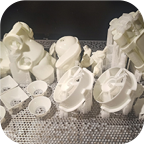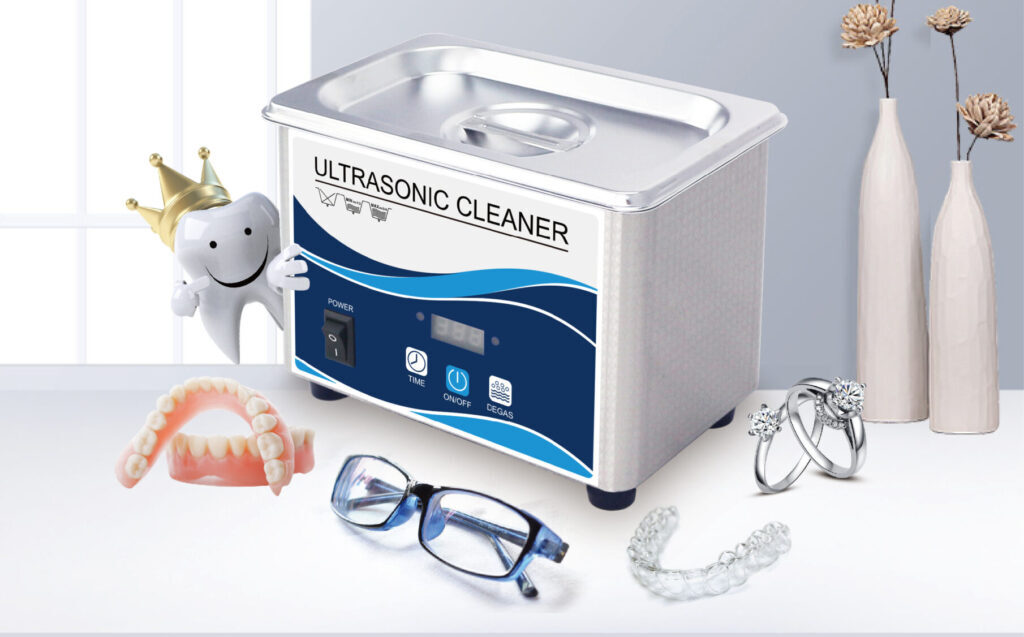Ultrasonic Cleaning for Glasses: How Safe and Effective Is It?
Browse Volume:3 Classify:Support
Anyone who wears glasses every day knows how quickly they can go from crystal-clear to cloudy and grimy. Despite our best efforts to wipe them clean, smudges, dust, and invisible residues always seem to return—often more quickly than we’d like. What makes glasses such magnets for dirt, and why is a better cleaning method so important?
Common Sources of Eyewear Buildup
Throughout the day, your glasses come into contact with a surprising variety of contaminants. Skin oils from your nose and temples, moisture from your breath, airborne dust, lint from your pockets or case, and even microscopic particles of pollution can settle on both the lenses and frame. Add to that the occasional fingerprint, makeup smudge, or splash from cooking—and you have a recipe for cloudy vision and constant frustration.
Frames, especially around the nose pads and hinges, are also hotspots for bacteria buildup. Because these areas are hard to reach with cloths or swabs, residue tends to accumulate over time, contributing to yellowing, odor, or discomfort on the skin.
How Dirt Affects Vision and Coatings Over Time
Dirty lenses aren’t just annoying—they can affect your vision and even shorten the life of your glasses. Light scatter from smudges and dust reduces contrast, creating glare and eye strain, especially when driving at night or working on screens. For people with high-index or blue-light blocking lenses, dirty surfaces can interfere with the coating’s optical performance.
Moreover, when we try to remove dirt using napkins, shirt sleeves, or dry tissues, we often create micro-scratches that dull the lenses over time. These tiny abrasions can’t be wiped away, and they build up gradually, leading to permanent damage that affects both clarity and comfort.
The Limitations of Manual Cleaning Methods
While microfiber cloths and cleaning sprays are useful tools, they only address what’s visible. Manual wiping doesn’t reach under the nose pads, between the frame joints, or inside the tiny screws and hinges. Even when lenses appear clean, the frames may still harbor grime and bacteria in places we can’t easily reach.
Additionally, the friction from constant wiping—especially when done hastily—can contribute to coating degradation. Some coatings, particularly anti-reflective or hydrophobic layers, are sensitive to repeated contact and may begin to peel or fade prematurely.
This is where ultrasonic cleaners come in—not just as a high-tech alternative, but as a safer, more comprehensive solution for keeping your glasses truly clean.
What Is Ultrasonic Cleaning and How Does It Work?
Ultrasonic cleaning may sound futuristic, but it’s built on a surprisingly simple and effective physical process. Originally developed for industrial and medical use, it’s now becoming popular among opticians and everyday glasses wearers alike—and for good reason.
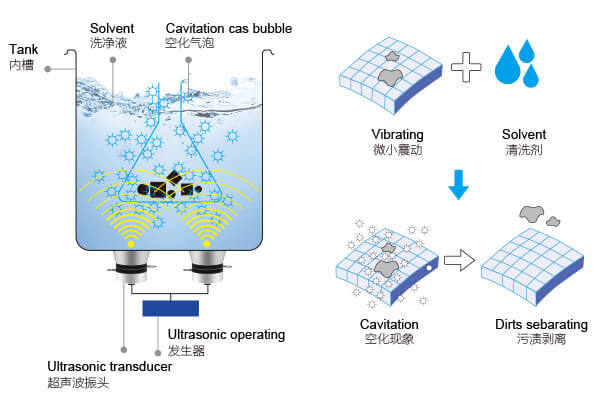
The Principle Behind Ultrasonic Cleaning
The Science of Cavitation in Eyewear Cleaning
At the core of every ultrasonic cleaner is a process called cavitation. This happens when high-frequency sound waves—usually between 20kHz and 200kHz—pass through a liquid. These sound waves create thousands of tiny vacuum bubbles that rapidly expand and collapse.
When these microscopic bubbles collapse near the surface of an object—in this case, your glasses—they release a concentrated burst of energy. That energy loosens and lifts away dirt, oil, and debris from surfaces and tiny crevices, all without causing physical abrasion.
What makes this process so valuable for cleaning glasses is its precision. Cavitation reaches into places that cloths and sprays can’t—such as under silicone nose pads, around lens rims, and inside hinge screws.

The cavitation effect of an ultrasonic cleaner
How Ultrasonic Cleaners Reach Invisible Areas
Traditional cleaning methods rely on physical contact: rubbing, scrubbing, or spraying. But ultrasonic cleaning works without direct contact. Once your glasses are submerged in the liquid-filled tank and the device is turned on, the sound waves do all the work. The liquid penetrates every surface of the frame and lenses, and the cavitation bubbles clean evenly and thoroughly.
This is particularly useful for:
- Removing grime and sweat trapped beneath nose pads
- Cleaning debris from between hinge mechanisms
- Lifting oils from the surface of anti-smudge coated lenses
- Sanitizing areas prone to bacterial buildup
And because the process is so gentle, it avoids the friction and scratching risks associated with repeated cloth wiping.
Why This Technology Appeals to Eyeglass Wearers
The appeal of ultrasonic cleaning isn’t just in the results—it’s in the effortlessness of the process. You don’t need to scrub, apply pressure, or worry about streaks. Simply place your glasses in the tank with the appropriate cleaning solution, turn on the device, and wait for the cleaning cycle to finish—usually around three to five minutes.
It’s a technology that offers consistency, safety, and precision, all in a compact unit that fits on a countertop. For anyone who wears glasses daily—especially those with expensive or coated lenses—ultrasonic cleaning can be a game-changer in terms of both hygiene and longevity.
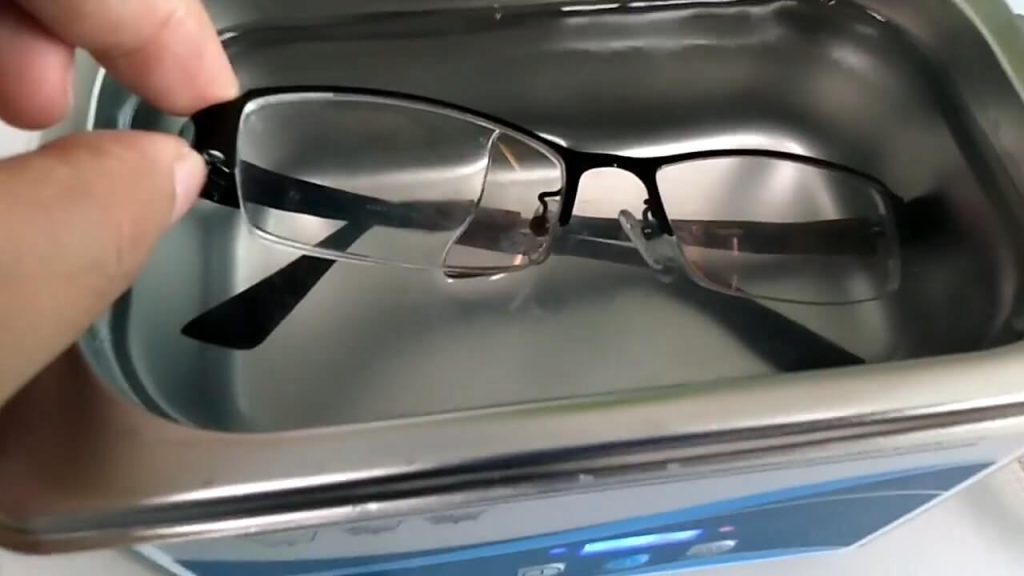
Inserting the glasses into the ultrasonic cleaning machine
Are Ultrasonic Cleaners Good for Glasses? A Closer Look
At first glance, ultrasonic cleaners seem like the perfect solution for keeping your eyewear spotless. But how well do they really work on glasses, and are there risks you should be aware of? The answer is nuanced—ultrasonic cleaners can be excellent for glasses when used correctly, but not every pair is equally suited to this method.
Cleaning Frames, Nose Pads, and Hinges
One of the biggest advantages of ultrasonic cleaning is its ability to clean entire frames—not just the lenses. Over time, sweat, oil, and dust accumulate around the nose pads and inside the hinges. These are areas where bacteria thrive and where manual cleaning methods simply fall short.
Ultrasonic waves reach all of these tight, hidden spots. When glasses are placed in the cleaning tank, cavitation bubbles form around every angle of the frame, including beneath the silicone or rubber pads, inside the screws, and along the temple arms. This results in a level of cleanliness that not only improves appearance but also reduces odors and skin irritation caused by unseen grime.
How Safe Is It for Lens Coatings?
The lenses are naturally the most sensitive part of any pair of glasses. Many modern lenses include anti-reflective, anti-smudge, or blue-light filtering coatings. These ultra-thin layers are what make your vision crisp and reduce eye strain—but they can be vulnerable to damage if treated incorrectly.
When used within the proper frequency and time limits, ultrasonic cleaning is safe for coated lenses. Most coatings are robust enough to handle short cleaning cycles, especially if the cleaner is set to around 40kHz and the water temperature stays below 50°C (122°F).
However, there are exceptions. Some older or low-quality coatings may begin to deteriorate with repeated exposure. If your glasses already show signs of coating peeling or hazing, it may be best to consult your optician before using an ultrasonic cleaner.
Tip: Always avoid using strong chemical additives in the cleaner that might react with lens coatings. Mild soap and distilled water are often enough for a thorough clean.
Frequency and Duration: What’s Ideal for Eyewear?
The best frequency for cleaning eyeglasses is generally around 40kHz, which offers a balance between cleaning power and gentleness. Lower frequencies like 25kHz are more aggressive and better suited for industrial parts—not lenses.
As for duration, most glasses require only 3 to 5 minutes of cleaning time. Running the cycle longer than necessary won’t make them any cleaner but may increase the risk of loosening screws or warming the lenses too much.
If your cleaner includes a heating function, check the temperature before starting. Warm water enhances cleaning but should not exceed the threshold that lens adhesives and coatings can tolerate.

The glasses are undergoing cleaning in the ultrasonic cleaner
Benefits of Using Ultrasonic Cleaners for Eyeglasses
With all the science and safety points considered, what exactly do you gain from using an ultrasonic cleaner for your glasses? The benefits are not only practical but also long-term. Regular ultrasonic cleaning helps maintain your eyewear in a way that manual methods can’t match.
Precision Cleaning Without Scratches
The most immediate and noticeable benefit is how thoroughly and gently ultrasonic cleaners clean your glasses. There’s no scrubbing, no wiping, and no abrasive contact. This significantly reduces the risk of creating micro-scratches on the lenses.
Even if you use microfiber cloths, tiny particles trapped on the surface can act like sandpaper. Ultrasonic cleaning avoids that entirely. The liquid medium and cavitation bubbles do all the work, lifting away grime layer by layer without friction.
This makes it especially valuable for:
- High-index lenses with delicate coatings
- Prescription sunglasses with mirrored or tinted films
- Designer eyewear with intricate frame designs
Time Savings and Ease of Use
Let’s face it: cleaning glasses properly takes time. You rinse them under warm water, lather with soap, rinse again, dry with a cloth, and still end up with streaks. Ultrasonic cleaning simplifies this process. Just fill the tank, insert your glasses, start the cycle, and wait a few minutes. Done.
The cleaner does all the work while you go about your day. There’s no pressure to scrub perfectly or worry about missing spots. For those who clean their glasses daily—or multiple pairs at once—this efficiency is a huge advantage.
Cleaner Glasses, Longer Lens Life
Regular, gentle cleaning extends the life of your lenses and frames. Dirt and oil are corrosive over time, especially when left to settle in the crevices of metal hinges or around plastic components. Keeping your glasses clean helps preserve the integrity of their coatings, materials, and moving parts.
For people who invest in premium lenses or designer frames, ultrasonic cleaning is a smart way to protect that investment. Over time, this method reduces the need for repairs, re-coatings, or premature replacements.
Are There Any Risks to Be Aware Of?
Despite the many benefits, ultrasonic cleaning is not without its risks—especially when it comes to glasses. While most eyeglass frames and lenses can be cleaned safely, certain conditions, materials, or misuse can result in damage. Understanding these risks will help you use ultrasonic cleaners correctly and avoid costly mistakes.
Anti-Reflective Coatings and Older Lenses
The majority of modern anti-reflective (AR) coatings are durable enough to withstand ultrasonic cleaning. However, older coatings—especially those applied years ago or on budget lenses—may not fare as well. Some coatings can begin to flake, haze, or delaminate if exposed to repeated ultrasonic cycles or heated water.
If your lenses already show signs of wear, clouding, or peeling, it’s best to avoid ultrasonic cleaning entirely or consult your optician first. For newer, well-maintained lenses, however, short ultrasonic cycles at the correct frequency are typically safe.
Another concern is lens adhesive failure in older or damaged glasses. Some adhesive points, especially in rimless or semi-rimless frames, may weaken under vibration or heat.
Heat and Duration Misuse
While most ultrasonic cleaners come with built-in heating, that doesn’t mean hotter is always better. Excessive heat can damage:
- Plastic frames, which may warp or discolor
- Lens coatings, which may separate from the surface
- Adhesive joints, which may soften or loosen under sustained temperature
An ideal cleaning temperature for glasses is around 35°C to 45°C (95°F to 113°F). Anything significantly above 50°C (122°F) increases the risk of damage.
Running long cleaning cycles is another mistake some users make. A five-minute cycle is generally enough for glasses. Extended use can gradually weaken small screws, wear down coatings, or simply overheat the lenses.
Cheap Cleaners Without Frequency Control
Not all ultrasonic cleaners are created equal. Low-cost, unregulated units from unknown brands may deliver inconsistent power and frequency. If the device operates at an unstable frequency—or worse, at a frequency too low (like 20–25kHz)—it may create larger, more aggressive cavitation bubbles. This type of cavitation is more suitable for cleaning metal machine parts than delicate eyewear.
Buying a reputable brand with verified frequency output (preferably around 40kHz) significantly reduces the risk of damage. Models that allow time, temperature, and frequency adjustment offer more control and flexibility for sensitive items like glasses.
Comparing Ultrasonic Cleaning to Other Eyeglass Cleaning Methods
Is ultrasonic cleaning the best method available, or just one of many? To answer that, it helps to compare it directly with other common ways people clean their glasses. Each method has its own strengths, but also limitations—especially when it comes to safety, thoroughness, and convenience.
Microfiber Cloths and Lens Sprays
This is the most common method people use: spray the lens, wipe with a microfiber cloth, and polish until it looks clean. While effective for surface-level dirt and smudges, this method depends entirely on manual effort and technique.
Drawbacks include:
- Missing buildup around hinges and nose pads
- Risk of scratching if the lens isn’t pre-rinsed
- Uneven cleaning if cloths are dirty or overused
That said, microfiber cloths are great for daily maintenance, especially for quick touch-ups on the go.
Ultrasonic cleaning complements this method by tackling areas that cloths can’t reach and by providing a deeper, safer clean.
Soap and Water at the Sink
Another popular technique is using mild dish soap and warm water, followed by gentle rubbing with your fingers and drying with a clean cloth. This method is recommended by many opticians because it’s gentle and avoids chemical sprays.
However, it has its limitations:
- Doesn’t fully remove dirt from joints, nose pads, or frame hinges
- Relies on good technique to avoid streaks
- Requires drying, which can reintroduce lint or dust
Ultrasonic cleaning can be used in tandem with this method: use soap and water for a quick clean, and ultrasonic for weekly deep cleaning.
Pre-Moistened Lens Wipes
These wipes are convenient, disposable, and often come in individually sealed packets. They’re useful for travelers and quick cleanups, but they have drawbacks:
- Not environmentally friendly due to single-use waste
- Can contain alcohol or ammonia, which are harmful to some coatings
- Still rely on manual pressure, which risks scratching
Compared to ultrasonic cleaning, wipes are less thorough and offer no cleaning action for frames or hard-to-reach areas.
Where Ultrasonic Cleaning Fits Best
Ultrasonic cleaners don’t necessarily replace the above methods—but they excel in certain scenarios:
- When glasses are heavily soiled with oil, sweat, or dust
- When frames have many moving parts or tight crevices
- When you want a contact-free cleaning method to protect coatings
- When you’re cleaning multiple pairs of glasses, such as in a household or clinic
Think of ultrasonic cleaning as a deep-cleaning tool. Just as you might use a washing machine for clothes rather than hand-washing every day, an ultrasonic cleaner offers convenience, consistency, and superior results for glasses when used correctly.
Who Should Use Ultrasonic Cleaners for Glasses?
Ultrasonic cleaners are not just for optical shops or hospitals. In fact, they’ve become increasingly popular among individuals and households, offering professional-grade cleaning with very little effort. That said, certain users benefit from ultrasonic cleaning more than others.
Everyday Eyeglass Wearers
If you wear your glasses daily—whether for reading, working at a screen, driving, or everything in between—you know how quickly smudges and dust accumulate. For those who:
- Clean their glasses multiple times a day
- Struggle with foggy, oily lenses
- Have sensitive skin that reacts to dirty frames
…an ultrasonic cleaner offers a hassle-free way to maintain clear, clean glasses without the wear and tear of constant manual wiping. It’s especially helpful for progressive lenses or frames with small design elements where dirt can hide.
Even if you only use it once or twice a week, the results will be noticeable—and long-term maintenance becomes much easier.
Opticians and Eyewear Professionals
Ultrasonic cleaners are a staple in optical shops and eye clinics for good reason. Professionals use them not only to clean clients’ glasses but also to service returned frames, prepare demo models, and ensure sanitation between patients.
In high-volume environments, ultrasonic cleaning:
- Saves time
- Reduces manual labor
- Enhances customer experience
- Improves hygiene and compliance
Many opticians also recommend ultrasonic cleaning to their clients and may sell compact models for home use.
People with Allergies or Skin Sensitivities
If you have sensitive skin, eczema, or allergies, you may notice irritation in the areas where your glasses contact your face. What you may not realize is that skin oils, cosmetic residue, sweat, and bacteria build up in nose pads and temples—often invisibly.
Ultrasonic cleaners remove this biofilm in a way that cloth wiping never can, helping reduce:
- Redness or soreness behind the ears
- Breakouts around the nose
- Unexplained itchiness where glasses touch the skin
For anyone with dermatological concerns, ultrasonic cleaning is a hygienic way to keep frames free from irritants and allergens.
Tips for Safely Cleaning Glasses in an Ultrasonic Cleaner
While ultrasonic cleaning is relatively simple, following best practices can make the difference between a routine clean and an accidental mishap. Whether you’re a new user or someone upgrading from manual methods, here’s how to get the most out of your device—safely.
Choosing the Right Cleaning Solution
Plain distilled water is the safest base liquid, especially if your cleaner does not recommend chemical additives. For more effective cleaning, add a small amount of mild dish soap—about one to two drops per 500ml.
Avoid the following:
- Alcohol-based solutions
- Ammonia (which damages coatings)
- Window cleaner
- Harsh industrial degreasers
Some companies offer eyewear-specific ultrasonic cleaning solutions, which are typically pH-neutral and safe for all coatings. If unsure, stick to soap and water.
Ideal Frequency and Temperature Settings
Most glasses respond best to frequencies between 40kHz and 45kHz. This range is effective at removing dirt while remaining gentle on coatings and adhesives.
Temperature settings are equally important. Warm, not hot water enhances cleaning, but don’t exceed 50°C (122°F). If your cleaner lacks a temperature gauge, test the water by touch—it should feel warm but never hot.
Lower temperatures are still effective, but may require slightly longer cycles.
Loading and Positioning Glasses Correctly
Place your glasses in the tank using a metal or plastic basket to suspend them above the tank bottom. This prevents vibration damage and allows cavitation to work evenly around the lenses and frame.
Make sure:
- Lenses face downward or angled to avoid air pockets
- Glasses are not touching the sidewalls of the tank
- Hinges and nose pads are fully submerged
- No other metal objects are clanking or touching the glasses
Avoid overloading the tank. Cleaning multiple items at once may reduce cavitation efficiency unless the device is specifically designed for it.
How Often Should You Clean Your Glasses This Way?
For most users, once or twice a week is ideal. Daily ultrasonic cleaning isn’t necessary unless your work or lifestyle exposes your glasses to high levels of dust, grease, or moisture.
Between ultrasonic sessions, you can maintain cleanliness with regular rinsing and microfiber cloths. Just avoid over-cleaning, which may eventually weaken coatings or frame joints if done too frequently with poor-quality equipment.
What to Look for in an Ultrasonic Cleaner for Eyewear
If you’ve decided that ultrasonic cleaning is right for your glasses, the next step is choosing the right device. With so many models on the market, selecting the best one can be overwhelming. But when it comes to eyewear, there are a few features that matter far more than fancy designs or high wattage.
Tank Size and Power for Personal Use
For cleaning glasses, you don’t need a large industrial cleaner. A compact unit with a tank capacity between 400ml and 1.2L is usually sufficient. This gives you enough space to fully submerge most frames without wasting cleaning solution.
As for power, a unit in the range of 30 to 60 watts is typically ideal for single pairs of glasses. More power isn’t necessarily better—especially for coated lenses. Excessive wattage without frequency regulation can damage delicate coatings or cause premature wear.
Check the tank dimensions as well—especially the depth and width—to make sure your glasses fit comfortably without bending the temples or forcing the lenses against the tank wall.
Features That Protect Lenses and Coatings
Look for units that offer:
- Stable 40kHz frequency output for gentle cavitation
- Timer controls, so you don’t over-clean accidentally
- Heating control, ideally adjustable or capped below 50°C
- Baskets or trays to keep glasses off the bottom of the tank
- Auto shut-off for added safety and energy efficiency
Bonus features such as digital displays, multiple cycle modes, or silent operation are nice to have, but not essential for effective cleaning.
Avoid models with vague specifications or no documentation about frequency, wattage, or cleaning duration. Trustworthy brands will provide these technical details clearly.
Should You Buy a Professional Model or a Home Unit?
This decision depends on how often you plan to use the cleaner and whether you’ll use it for more than just glasses.
- Choose a home unit if you’re cleaning 1–2 pairs per week and want a quiet, compact device
- Consider a professional model if you’re an optician, glasses retailer, or plan to clean multiple pairs daily or include tools, lenses, or other accessories
Home units are generally priced between $30–$100, while professional tabletop models may cost $150–$300+ depending on capacity and features.
As with all tools, the best unit is the one that fits your routine—not necessarily the most expensive one.
Final Thoughts: Is Ultrasonic Cleaning the Best Way to Clean Glasses?
If you value clean, clear lenses and the long-term condition of your eyewear, ultrasonic cleaning is hard to beat. It’s a method that combines scientific precision with everyday convenience, offering results that are difficult—if not impossible—to replicate by hand.
Ultrasonic cleaners do more than just remove smudges. They sanitize, protect, and extend the life of your frames and lenses. They’re particularly valuable if you wear glasses daily, own multiple pairs, or struggle with skin irritation due to buildup on your frames.
That said, ultrasonic cleaning isn’t a silver bullet. It should be used correctly and in moderation, and not every lens or coating is a perfect match. When used responsibly, though, it becomes a powerful tool for maintaining eyewear hygiene and comfort.
Whether you’re an optician, a lifelong glasses wearer, or someone who’s simply tired of constantly wiping away fingerprints, investing in a quality ultrasonic cleaner can transform how you care for your glasses—making them feel like new, week after week.
Previous: Do Ultrasonic Cleaners Really Work?
 Granbo Sonic
Granbo Sonic


